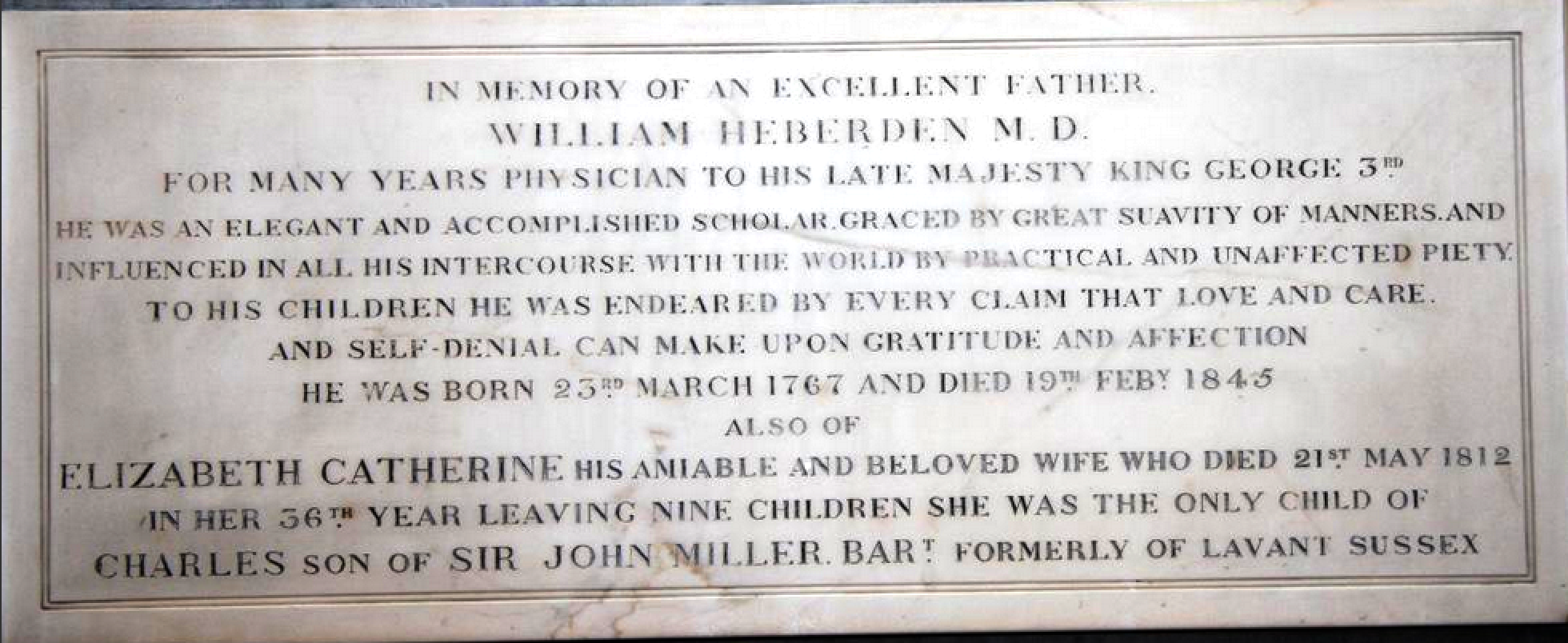
Ancestry of George Heberden (*1833)
| Page DA III.5 to overview | |||||||||||||||||||
|
|
|
| ||||||||||||||||
|
| ||||||||||||||||||
| |||||||||||||||||||
George Heberden |
|||||||||||||||||||
William Heberden and Mary Wollaston
William was first married to Elizabeth, daughter of John Martin of
Overbury.
They married June 1752 at St Martins in the Fields, she died
26/11/1754 and was burried at Overbury.

|
William Heberden had a distinguished career.1 Entered St Saviour's Grammar School aged 7 (his father died that year) and showed prowess in Greek, latin and divinity, so that he could go 1724 to St John's College, MA in 1732, to become MD in 1739. He remained ten years at Cambridge practicing medicine, and gave an annual course on materia medica.
Heberden, who was also a classical scholar, published several papers in the Philosophical Transactions of the Royal Society; and among his noteworthy contributions to the Medical Transactions (issued, largely at his suggestion, by the College of Physicians) were papers on chickenpox (1767) and angina pectoris (1768). His Commentarii de morborum historia et curatione, the result of notes made in his pocket-book at the bedside of his patients, were published in 1802 and again in 1807. In the year following the first edition, an English translation appeared, and further publications in 1806 and 1818. The English translation is believed to be from the pen of his son, William Heberden (1767–1845; see below).
Heberden studied the painful inflammation of the finger joints, especially those toward the end of the fingers, swellings now know as due to osteoartritis. The hard bony swellings are since called Heberden Nodes (published by him as a chapter in his "Commentaries on The History and Cure of Diseases").
At the age of seventy-two he partially retired, spending his summers at a house he had taken at Windsor, but he continued to practice in London during the winter for some years longer. William died in 1801. His tomb is in Windsor Parish Church. Mary died 22/02/1813 aged 83.
William Heberden (later also called the Younger) and Elizabeth Catherine Miller
Elizabeth was daugther (and heir) of
Charles Miller of Shopwich Oving Co. Essex.
Children:
William *08/01/1797, married Elvina Underwood (see below);
Charles *06/04/1799, Barrister at law of Lincoln Inns (1832);
|
|
William was educated at Charterhouse School and St John's College, Oxford and followed his father into medicine becoming the Physician at St George's Hospital (1793–1803).
See also W Heberden the Younger in Wikipedia.
He was elected a Fellow of the Royal Society in 1791.
William also invested in psychiatric treatments
(see "The psychiatric efforts of William Heberden Jr.",
Cantu & Cantu, Bull. Hist Med 41:132-139, 1967).

|
William Heberden and Elvina Ranier Underwood
|
|
St Nicolas Church, Great Bookham |
Charles Miller and NN
He was from Lavant.
He and his wife had only one child: Elizabeth Catherine.
Michael Underwood and NN
Underwood was the first physician‐accoucheur to be appointed to the Royal College of Physicians in London. The same year, 1784, he published a textbook which did much to establish paediatrics as an emerging discipline in its own right.
He is a relevant figure in the history of medicine and pediatrics for having given the first known description of several childhood diseases, infantile paralysis included.
See Underwood Wikipedia.
and
M Underwood, by P.M. Dunn (2006).
Underwood was appointed physician to the Princess of Wales (wife of
the future George IV), and, in 1796, attended the birth of her daughter, the Princess Charlotte.
John Holen Underwood and Sarah
John became assistant surgeon in Fort St George, Madras, on the south-eastern coast of India.
There, in 1797, he initiated a hospital for the indigent Indians.
Children a.o.:
John James, *1797 Fort St. George, Madras, East Indies;
Camilla Ann, *ca.1799 (married 1817 Robert Greig);
Frederick Forbes, *1805 Madras;
Elvina Ranier, *1806 Madras;
"daughter" by "Lady of" J.Underwood *1808.
For more on him see da553m.
1 The information above was taken foremost from
William Heberden in Wikipedia, where numerous sentences
are taken from the Encyclopedia Brittanica, Vol. 13, p.167.
The British Herald, or Cabinet of Armorial Bearings of the Nobility
& Gentry of Great Britain & Ireland, by Thomas Robson, Vol II, 1830.
(2021.07.07) begun August 2020